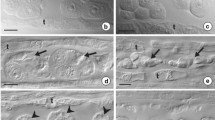Summary
Early stages of egg embryony and antipodal embryony in ovules from both pollinated and unpollinated flowers ofAllium tuberosum, a diplosporous apomict, were observed. Whether flowers were pollinated or not, autonomous egg and antipodal embryonies occurred at nearly equal frequencies and progressed almost synchronously for several days. An electrophoretic analysis of endosperm esterase demonstrated the fertilization of polar nuclei. It was thus confirmed thatA. tuberosum is a pseudogamous apomict. The degree of parthenogenesis, calculated as the percentage of ovules in which egg cells showed autonomous embryonic development, ranged between 62% and 94% among six cultivars and was nearly equal to the degree of diplospory previously reported. The present results show that most unreduced egg cells and egg-like antipodal cells ofA. tuberosum have the ability to start embryogenesis independently of pollination.
Similar content being viewed by others
References
Asker S (1977) Pseudogamy, hybridization and evolution inPotentilla. Hereditas 87:179–184
Asker S (1979) Progress in apomixis research. Hereditas 91:231–240
Haberlandt G (1923) Zur Embryologie vonAllium odorum L. Ber Dtsch Bot Ges 41:174–179
Haberlandt G (1925) Zur Embryologie und Cytologie vonAllium odorum L. Ber Dtsch Bot Ges 43:559–564
Håkansson A (1951) Parthenogenesis inAllium. Bot Not 1951: 143–179
Hanna WW, Bashaw EC (1987) Apomixis: its identification and use in plant breeding. Crop Sci 27:1136–1139
Hegelmaier F (1897) Zur Kenntnis der Polyembryonie vonAllium odorum L. Bot Ztg 55:133–140
Herr JM Jr (1982) An analysis of methods for permanently mounting ovules cleared in four- and-a-half type clearing fluids. Stain Technol 57:161–169
Kojima A, Nagato Y (1992) Diplosporous embryosac formation and the degree of diplospory inAllium tuberosum. Sex Plant Reprod 5:72–78
Kojima A, Hinata K, Noda S (1991a) An improvement of squash method for the cytological study of female meiosis inAllium tuberosum, Liliaceae. Chromosome Inf Serv No. 50:5–7
Kojima A, Nagato Y, Hinata K (1991b) Degree of apomixis in Chinese chive (Allium tuberosum) estimated by esterase isozyme analysis. Jpn J Breed 41:73–83
Modilewski J (1930) Neue Beiträge zur Polyembryonie vonAllium odorum. Ber Dtsch Bot Ges 48:285–294
Nogler GA (1975) Genetics of apospory inRanunculus auricomus. IV. Embryology of F3 and F4 backcross offspring. Phytomorphology 25:485–490
Nogler GA (1984) Gametophytic apomixis. In: Johri BM (ed) Embryology of angiosperms. Springer, Berlin Heidelberg New York, pp 475–518
Petrov DF (1976) Genetically regulated apomixis as a method of fixing heterosis and its significance in breeding. In: Khokhlov SS (ed) Apomixis and breeding (translation of: Apomiksis i selektsiya. Nauka, Moscow, 1970). Amerind, New Delhi, pp 18–28
Tretjakow S (1895) Die Beteiligung der Antipoden in Fällen der Polyembryonie beiAllium odorum L. Ber Dtsch Bot Ges 13: 13–17
Weber E (1929) Entwicklungsgeschichtliche Untersuchungen über die GattungAllium. Bot Arch 25:1–44
Zar JH (1974) Biostatistical analysis. Prentice-Hall, Englewood Cliffs
Author information
Authors and Affiliations
Rights and permissions
About this article
Cite this article
Kojima, A., Nagato, Y. Pseudogamous embryogenesis and the degree of parthenogenesis inAllium tuberosum . Sexual Plant Reprod 5, 79–85 (1992). https://doi.org/10.1007/BF00714561
Issue Date:
DOI: https://doi.org/10.1007/BF00714561




